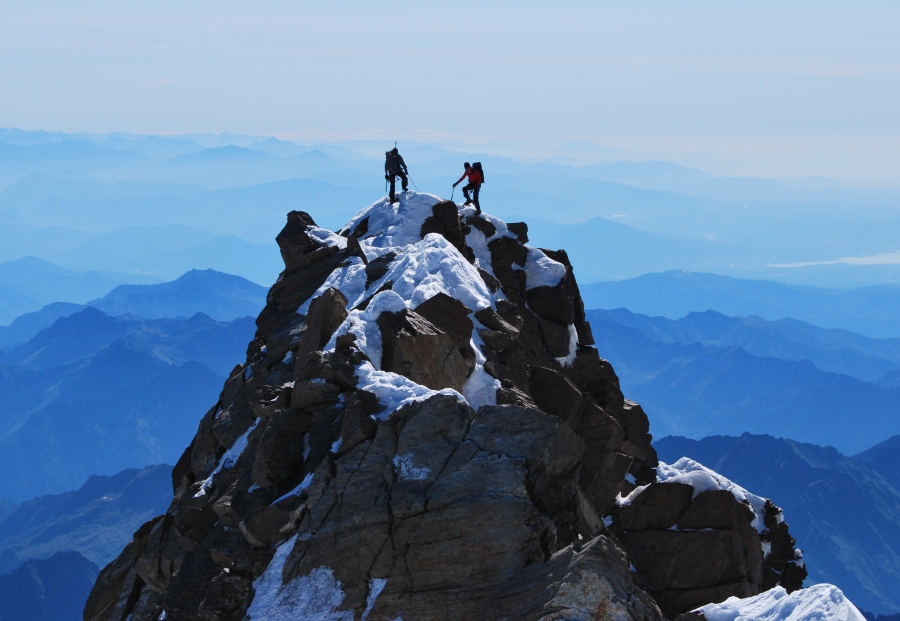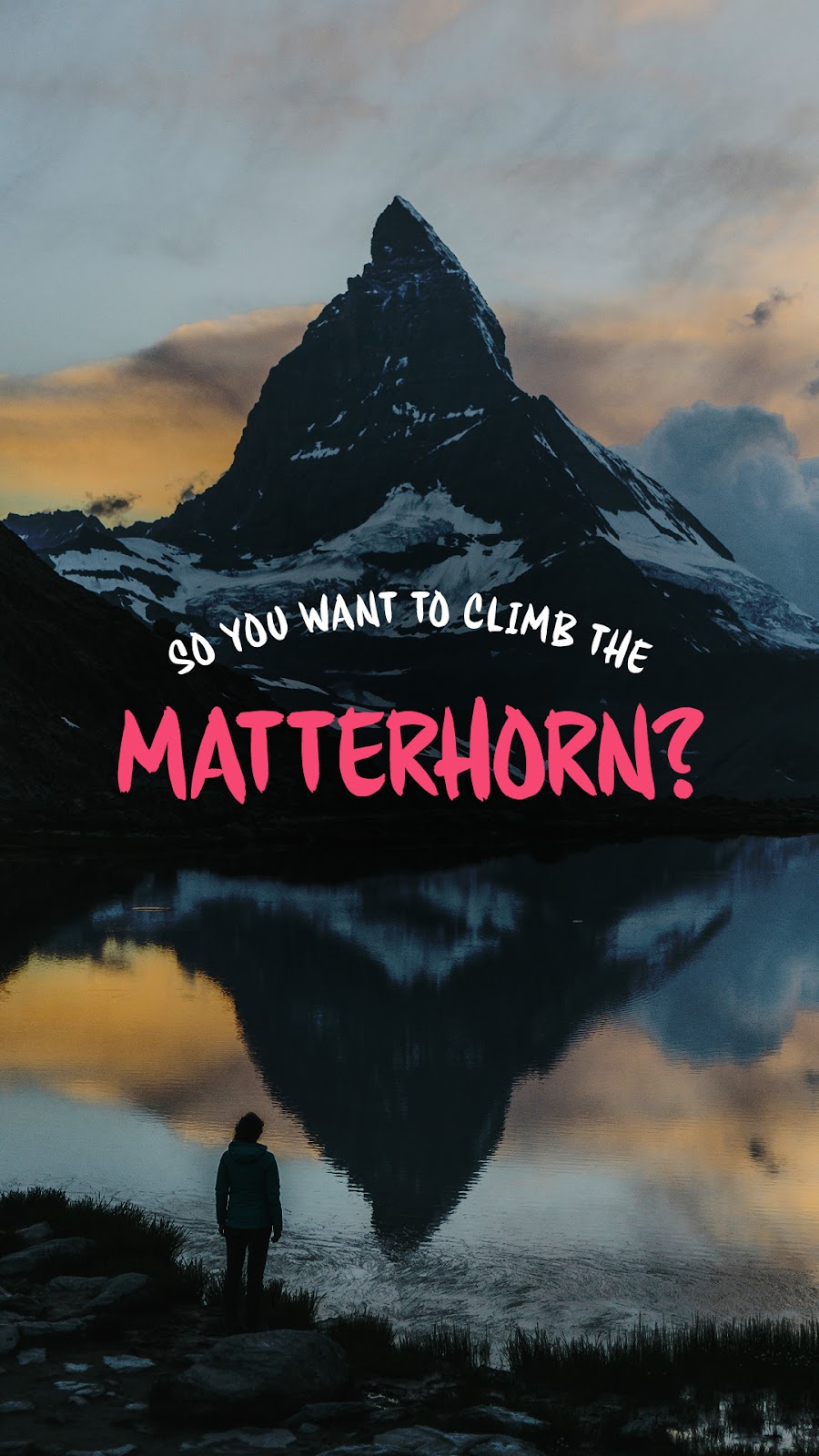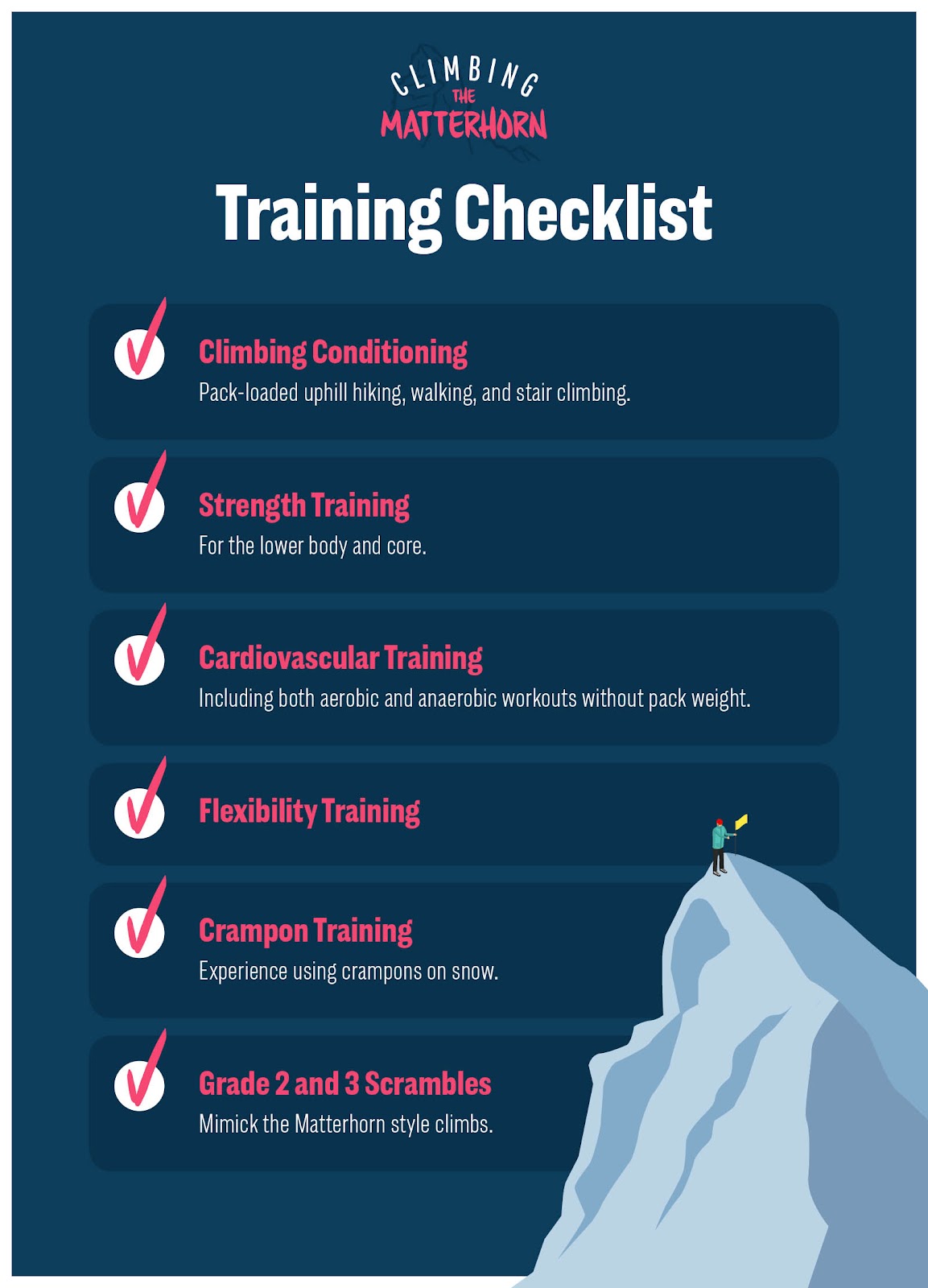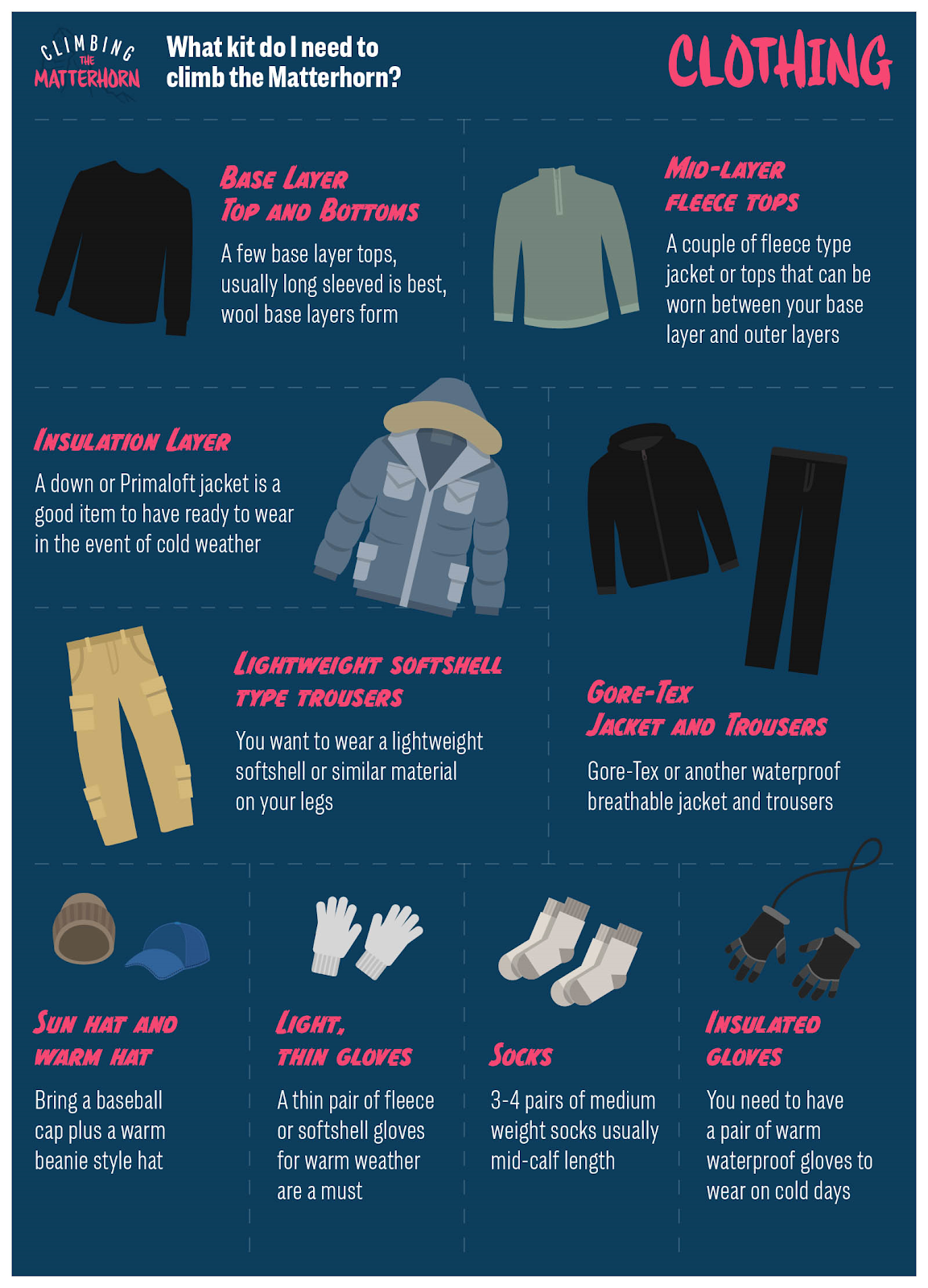Written by Matt Dickinson (IFMGA Mountain Guide)
14th October 2020
Matterhon Climber, How hard is climbing Matterhorn

So You Want To Climb The Matterhorn?

The Matterhorn is the most easily recognised peak in the world. Isolated at the head of the Zermatt Valley, the perfectly shaped mountain needs little introduction and continues to top the ‘must do’ list of thousands of climbers who aspire to climb it each year.
But if this is the first time you’ve considered climbing the Matterhorn, you might be wondering - how difficult is it?
Well, that’s a question we are asked frequently. The fact is, looking from Zermatt, the peak looks nothing short of terrifying and compared to most alpine peaks, the assent looks impossibly steep and uncompromising.
To find out how difficult it is to climb the Matterhorn, we’ve invited IFMGA Mountain Guide, Matt Dickinson to give us his tips on reaching the summit successfully. Having helped hundreds of people climb the Matterhorn throughout his time with Mountain Tracks, Matt knows what it takes to reach the top.
What do I need to know before climbing the Matterhorn?

How difficult is it to climb the Matterhorn?
There are three key attributes needed for a successful ascent of the Matterhorn. These are fitness, determination and a thing we call “sure-footedness”. I’ll explain each one in a little more detail separately.
Fitness
Typically the summit day is between 9-12 hours of pretty much non-stop climbing with short breaks. So it’s physically tough and you need to have extremely good fitness levels.
There is an old joke regarding the lack of rest stops on the climb. A British climber was tired on the approach to the Solvay hut (halfway refuge), so he says to his Zermatt guide "please can we rest and have a drink", to which the Zermatt guide replies "yes, at the Solvay Hut". When they get to the Solvay hut the guide does not stop. The British climber, says "I thought we could stop for a rest at the Solvay hut" to which the Guide replies "yes that's right, on the way down"!
The story is a little tongue in cheek, but it does give you an idea of the type of fitness needed to climb the Matterhorn.
Sure-footedness
Sure-footedness is of prime importance on the Matterhorn. Sure-footedness is different to climbing ability. I have guided experienced climbers who are not sure footed and non-climbers who are surefooted. This simply means the ability to be agile and secure when scrambling on rock, ice and snow. This ability can be learned by practising scrambling and easy climbing. Climbing on the Matterhorn is not particularly hard, but it is exposed. That means it is important not to take a fall.
Determination
Determination is important. But no amount of determination will make up for a lack of fitness. Do the groundwork, build up your fitness levels and prepare yourself mentally before taking on the Matterhorn. Saying that, even if you’re fit enough, the bigger problem is the exposure. Lots of climbers can’t handle the risk and quickly return from their ascent. You need a strong desire and will to make this climb.
How to Prepare for Climbing the Matterhorn?
A successful ascent of the Matterhorn demands a lot from a climber. Fitness and determination are paramount but technical competence and sure-footedness are hugely important. You need to be prepared for 9 to 12 hours of Grade 2 or 3 scrambling terrain. Many mountain guides, such as Mountain Tracks, offer the training you need.
Take a look at our Matterhorn training weekend here:

You will also need:
- Experience using crampons on snow. The final third of the ascent is often on snow.
- Experience scrambling in Snowdonia or the Culin Ridge. Mountain Tracks offer this training by mimicking as many Matterhorn style grade 2 and 3 scrambles until you are comfortable.
- A period of acclimatisation of around four or five days, including sleeping at altitude. This is often achieved by climbing the Monte Rosa massif.
- Experience sustaining physical effort on hiking or scrambling terrain for long periods of time.
- Experience controlling your body during downclimbing.
It’s critical you have the fitness required to climb the Matterhorn by completing several intensive hikes or scrambles.
Do you need a mountain guide to climb the Matterhorn?
The route is both complex and loose, so it is crucial that the leader knows the mountain well. We would never advise attempting the peak without using a qualified guide. We recommend taking a look at our Matterhorn Climber holiday here. Climbing with a dedicated IFMGA Mountain Guide, you will spend 6 full days preparing for and eventually climbing the world’s most iconic mountain, all with an experienced and dedicated professional.
What routes can you climb up the Matterhorn?
There are four main routes up the Matterhorn. The most popular route, and the route taken by Mountain Tracks, is via the Hornli Ridge from Zermatt.
The other three routes are:
- The South West/Italian Ridge (Lion Ridge)
- The North West or Zmutt Ridge
- The North Face or Schmid Route
How dangerous is climbing the Matterhorn?
Each route has its dangers. You will find long rock climbs with steep snow at altitude and plenty of exposure on all Matterhorn routes. However, Hornli ridge offers a moderately technical ascent and is littered in climbers throughout the summer. The best route overall.
When climbed via the Hornli ridge, the Matterhorn ascent is graded AD with a vertical height gain of 1300m (from the Hornli refuge). The climbing is never more difficult than the British grade 'Moderate'. It is mainly on rock, however, the upper section is usually snow and ice. The most difficult sections have fixed ropes.
What kit do I need to climb the Matterhorn?
It’s important you have the right kit to climb the Matterhorn. During the summer the weather can start out very cold and gradually get very hot by the afternoon. It is therefore essential that you have a variety of layers to put on/take off as the conditions change.
Our recommended kit list includes:
Clothing

- Base Layer Top and Bottoms – a few base layer tops, usually long sleeved, are best wool base layers form.
- Mid-layer fleece tops – a couple of fleece type jackets or tops that can be worn between your base layer and outer layers.
- Insulation Layer - a down or Primaloft jacket is a good item to have ready to wear in the event of cold weather.
- Lightweight softshell type trousers - you want to wear a lightweight softshell or similar material on your legs.
- Walking shorts or a pair of trousers with zip-off legs.
- Gore-Tex Jacket - Gore-Tex or another waterproof breathable jacket.
- Gore-Tex Pants - Gore-Tex or other waterproof breathable trousers.
- Sun hat and warm hat – bring a baseball cap plus a warm beanie style hat.
- Light, thin gloves – a thin pair of fleece or softshell gloves for warm weather are a must.
- Insulated gloves - You need to have a pair of waterproof warm gloves to wear on cold days.
- Gaiters – these are useful to wear to keep snow out of your boots.
- Socks - 3-4 pairs of medium weight socks, usually mid-calf length, is good.
Technical

- Alpine Mountaineering Boots
- Climbing helmet
- Ice Axe - General mountaineering / alpine pick 55-70cms long depending on your height.
- Boot crampons - with anti-balling plates.
- Climbing Harness – adjustable leg loops are useful for putting over your boots.
- Adjustable trekking pole(s)
Miscellaneous

- Rucksack - A simple and lightweight pack with a capacity of between 35-45 litres is recommended.
- Lightweight sleeping bag liner – a silk or cotton sleeping bag liner is now compulsory in all mountain huts
- Water bottle or Thermos – a water bottle or hydration system is needed.
- Head torch with spare batteries
- Penknife
- Personal First Aid Kit (Plasters, pain killers, antiseptic cream, blister kit)
(Note: Guides will have comprehensive first aid kits and are qualified in mountain first aid)
- Whistle
- Sun Glasses - minimum category 3)
- Ski Goggles – these can be very useful if you encounter strong winds and poor weather.
- Sunscreen and Lip Protection
- Ear Plugs - For noisy huts!!
- Camera
- Hold-all bag - for gear not required on the trek. This will be left at the hotel and collected on return.
- Passport
- Money - You will need some cash for food and drinks.
- Toiletries (toothpaste, soap, wet wipes, toilet paper etc.)
- Alpine club card - If you're a member.
- Book, pack of cards and or iPod/MP3 player
Should I climb the Matterhorn?
There is no doubt that climbing the Matterhorn is an intensely satisfying experience and one which will stay with you for a lifetime. Plus, everybody has heard of the Matterhorn, so it is instantly recognised by family and friends. If you need a little more convincing, take a look at these 19 reasons to never climb the Matterhorn.
Join the Matterhorn Club with Mountain Tracks
At Mountain Tracks, we offer Matterhorn courses from July - September.
The courses are run over 6 days. They include 4 days of training and acclimatisation climbs around Zermatt or Saas Grund prior to the 2 day Matterhorn ascent.
4 Days Training and Acclimatisation
2 Days Matterhorn Ascent
Participants should have some alpine mountaineering experience before the Matterhorn week, although being an expert climber is not a prerequisite.
For more information or to book this unforgettable climb Click Here.
 Off-Piste
Off-Piste Ski Touring
Ski Touring Via Ferrata
Via Ferrata Ice Climbing
Ice Climbing Alpine Glacier Trekking
Alpine Glacier Trekking Worldwide Trekking
Worldwide Trekking




 Travel Website Development
Travel Website Development